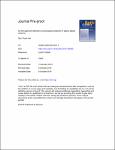Item Infomation
Full metadata record
| DC Field | Value | Language |
|---|---|---|
| dc.contributor.author | Đào, Thanh Hải | - |
| dc.contributor.author | Dao, Thanh Hai | - |
| dc.date.accessioned | 2020-06-09T08:32:14Z | - |
| dc.date.available | 2020-06-09T08:32:14Z | - |
| dc.date.issued | 2020 | - |
| dc.identifier.uri | https://dlib.phenikaa-uni.edu.vn/handle/PNK/374 | - |
| dc.description.abstract | Elastic optical networks technologies feature several benefits including higher spectral efficiency, system capacity and therefore have been widely viewed as the promising paradigm for next-generation optical transport networks. Dedicated path protection for elastic optical networks has been of ever-increasing importance in the era of information society thanks to its near-immediate recovery speed and remarkably simple operations in guaranteeing the connectivity of information flows. Inspired by the observation that the today premium network traffic traveling in fiber links accounts for roughly 25% of total traffic and the best-effort traffic constitutes the remaining, we propose a new design for elastic optical networks with dedicated path protection tailoring to the actual traffic profile rather than enforcing the same protection service for both traffic types as with conventional approaches. Our proposal exploits the flexible baud-rate transponders shared between the working and protection mode, featuring lower baud-rate operation for protection mode to provide just enough bandwidth for premium traffic. To maximize the impact of protection service differentiation, we present a novel integer linear programming taking into account the proposed quality-of-service-aware protection aiming at minimizing the spectrum usage. Numerical results on a realistic topology, COST239, are provided to assess the efficiency of our proposal compared to the traditional approach and it has been highlighted that having quality-of-service-aware protection being adapted to the actual traffic characteristic presents significant spectrum savings. With the current estimate of premium traffic of 25%, our study suggests that more than 30% spectral saving could be achieved and generally the low-load condition is more profitable than the medium and high-load ones. | vi |
| dc.language.iso | en | vi |
| dc.publisher | Elsevier | vi |
| dc.subject | Elastic optical network | vi |
| dc.subject | Dedicated protection | vi |
| dc.subject | Optical communications | vi |
| dc.subject | Flexible transponder | vi |
| dc.subject | Quality-of-service | vi |
| dc.title | On the spectrum-efficiency of QoS-aware protection in elastic optical networks | vi |
| dc.type | Article | vi |
| eperson.identifier.doi | https://doi.org/10.1016/j.ijleo.2019.163563 | - |
| Appears in Collections | ||
| Bài báo khoa học | ||
Files in This Item:

